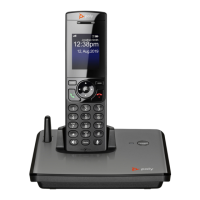Service Providers
51
For more information on ITSP RTP settings parameters, see the ITSP Profile X – RTP Web Page (X = A, B,
C, D, E, F, G, H) Parameter Guide table in the Parameter Reference section.
Using SPn as a Proxy for a SIP IP Phone
An SP service can be set up as a proxy for a legacy IP phone to let the phone access OBiTALK or
OBiBlueTooth (on SPn) installed on the device. This proxy mode of operation must be explicitly enabled in
the SP ‘s configuration on the device. It is disabled by default. The IP phone using this proxy service is
known as the local_client of the SP service. It must be installed on the LAN side of the device.
In this mode, SPn accepts SIP Registration from the client device from the LAN side, which must be using
the same user-id and password as this SPn’s AuthUserName and AuthPassword parameters for
authentication. This client device can also send SIP INVITE to the device at this SP to make calls. This SP’s
InboundCallRoute must be set up with the proper routing rule to handle calls from the local_client.
The SIP Proxy Server parameter on the client device must be sent to:
<obi-number>.pnn.obihai.com:<spn-user-agent-port>
where <obi-number> is the 9-digit OBi number of this device, and <spn-user-agent-port> is SPn’s
X_UserAgentPort parameter.
For example, SP1 has a local_client with the user-id 4086578118. The client wishes to make and receive
calls on SP3. The SP1 InboundCallRoute shall include the following rule:
{4086578118>:sp3}
The SP3 InboundCallRoute shall be: {sp1(408657118@local_client)}
For more information on SPn services parameters, see the
SPn Services (n = 1, 2, 3, 4, 5, 6, 7, 8) Settings
table in the Parameter Reference
section.
OBiTALK Service Settings
For more information on OBiTALK calling features parameters, see the OBiTALK Calling Features
Parameter Guide table in the Parameter Reference section.

